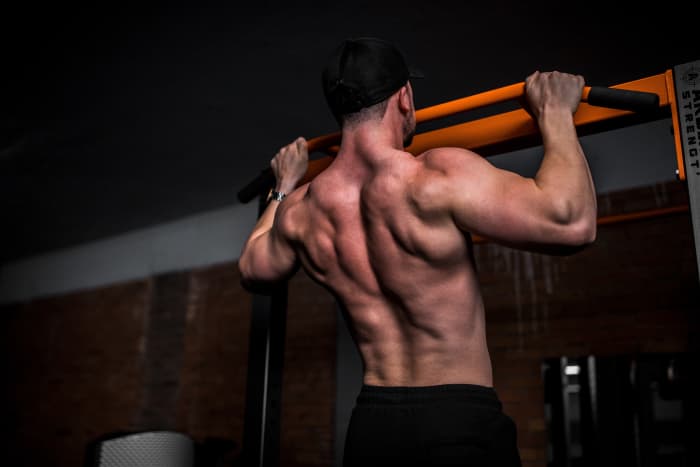
Ten exercises to help you build bigger back and bicep muscles.
Photo by Edgar Chaparro on Unsplash: Canva
The back is comprised of many muscles like the rhomboids, latissimus dorsi, erector spinae, and trapezius. The strength of our backs can affect our posture, energy levels, and our appearance. Some people in society are focused on the muscles that they can see in the mirror easily. Men tend to want to get a bigger chest with ripped abs. Women generally want to get stronger legs with a bigger booty. It’s important to train your entire body for health. Balance is key to staying healthy and creating a balanced physique. Muscle imbalances can cause posture problems, strength imbalances, or even cause injuries.
Benefits of Training the Back Muscles
Training your back muscles can help you build bigger arms. Many back movements require a certain degree of grip strength that can build your forearm and bicep muscles. Barbell and dumbbell curls build the biceps directly, but certain back movements can increase your bicep size when you apply extra resistance over time while maintaining good form. Biceps are usually the secondary muscle that helps you pull the weight in rowing movements. In some cases, making progress in your back workouts will build more bicep hypertrophy because you can handle more weight than isolation exercises.
Many people in society work in sedentary jobs where they are sitting at a chair for half the day or longer. All that sitting can cause poor posture, particularly if the person is hunched over or does not take breaks to stretch enough. Driving and playing video games for extended periods can also hurt our posture. Exercising the back can help mitigate the posture issues we get in our lives, careers, daily activities, and hobbies.
While there’s nothing inherently wrong with having a day reserved for training your back muscles, consider doing pulling exercises on your push workouts days. The chest and back are antagonistic, muscles that are opposites. Most chest exercises involve pushing something away from you. Back exercises usually involve pulling something toward you or pulling your body to something. Personally, I like to superset overhead pressing with seated rows because I can get my workout done faster. It also allows me to balance my physique out. Injuries or muscle imbalances can occur if your pectoral muscles and front delts are significantly stronger than your upper and lower back.

Pull-ups can improve posture and make the back wider while increasing your bicep power
10 Exercises To Get a Thicker and Wider Back
Below are 10 back movements that can increase the muscle and strength of your back and biceps when done correctly.
1. Pull-Ups for a V-Taper
One of the best compound exercises for the upper body is the pull-up. It is a good way to determine how strong a person’s upper back and arms are. Pull-ups are often utilized in military training to test new recruits. If a person is out of shape or too overweight, they will struggle with the exercise. Some people can’t even do a single pull-up! Consider yourself pretty strong if you can do 10 consecutive pull-ups with good technique and range-of-motion.
Making progress on pull-ups can create a V-Taper physique that makes your body appear wider. The latissimus dorsi (lats) are the primary mover. They get wider and bigger when you progress. A pull-up is done with an overhand grip. In general, a wider grip is more challenging, but that will vary from person to person.
2. Chin-Ups for More Bicep
A chin-up is still technically a pull-up, but you utilize an underhand grip instead. A supinated grip means that your palms are facing you. Chin-ups are a great way to work the bicep muscles. Make sure to pull your chin above the bar, then lower yourself in a controlled manner. The eccentric part (when you lower yourself) of the exercise is important, as that helps to induce hypertrophy and strength. Moving too fast can cause serious injury or simply make the movement less effective.
The weighted pull-up or chin-up is one of the best methods of gaining extra size and strength. Personally, I alternate between bodyweight pull-ups and weighted chin-ups. I’ve made excellent results over the years. The best way to add resistance is by using a dip belt, weighted backpack, or ankle weights. Be careful when adding resistance, as you don’t want a weight plate or dumbbell to fall on your foot!
Gyms usually have pull-up bars in squat racks or other exercise stations. Sometimes they’ll be mounted to the walls. Websites and stores sell free standing pull-up bars that you can purchase to use at home.

Controlling the weight on a lat pull-down is key if you want good results
3. Lat Pull-Downs
Most commercial gyms have some type of lat pull-down machine. Lat pull-downs are beneficial for people who do not possess the strength to perform a pull-up. They work many of the same muscles as a pull-up, but your bodyweight is not a factor. Your lats and biceps are activated when pulling the bar down to your chest.
If you’re beginner, make sure not to go too heavy. Find a weight that is challenging, but not so difficult that it causes your technique to breakdown. Try doing 3-4 sets of 10 repetitions. Control both the concentric and eccentric portion of the lift. Try different handle attachments to hit your back and biceps a bit differently.
Don’t use your bodyweight to lift more weight on the lat pull-down. Pulling the weight down with the leverage of half your bodyweight takes the pressure off your lats and biceps. It’s a form of cheating that will result in poor or mediocre results.
4. Chest Supported T-Bar Rows
If you don’t want to place too much stress on your lower back or hips, then try the chest supported T-Bar Row, an isolation exercise. The T-Bar Row is a horizontal pulling movement that primarily targets the rhomboids, rear delts, traps, lats, and biceps. A neutral grip will emphasize the lats more. A regular overhand grip will generally work the upper areas of the back.
Most T-Bar rows are at a 45 degree angle. Adjust the foot plate according to your height. The chest pad should be around the center of your chest. You should be supported while having freedom of movement. The pad should not be too close to your chin, for example. Keep your chest close to the pad while pulling the weight toward you, then lower it. Pause the weight at the top to make the exercise more challenging.
Deadlifts build a lot of power in the back and entire body
5. Seated Cable Rows
For this isolation exercise, you’ll need access to a low pulley row machine and a V-Bar attachment. The V-Bar gives you a neutral grip where the palms of your hands face each other. Sit down on the machine and place your feet on the front platform. Make sure your knees are slightly bent. Lean over as you maintain the natural alignment of your back. Grab the V-bar handles. With your arms extended, pull back until your torso is at a 90-degree angle from your legs. Your back should be slightly arched, and your chest should be sticking out. That is the starting position of the exercise. Keep your torso stationary. Pull the V-bar toward your stomach.
The biceps and triceps act as dynamic stabilizers on seated cable rows. You’ll mainly work the muscles in the upper and middle part of your back, particularly the lats. Focus on holding the contraction during each repetition. Maintain proper posture without using momentum.
6. Conventional Deadlifts
Deadlifts are one of the compound exercises that are used in powerlifting competitions. They work your upper back, lower back, traps, hip flexors, glutes, and hamstrings. If you don’t use lifting straps, they’ll give your forearms a good workout too. Deadlifts can be done on your leg or back workouts. It comes down to personal preference.
While the deadlift can pack on a serious amount of muscle mass and strength, it must be done correctly! Many people get injured because they round their lower back, go too heavy, hyperextend, or train with too much volume. Using a mixed grip on the barbell can cause a bicep injury if you don’t keep your arms straight.
Before lifting the barbell off the floor, your chest should be up with a neutral spine. Keep the bar close to your shins. Wear socks or protective pads if the bar hurts your shins. The deadlift is a hinging movement, not a squat. A rounded lower back when performing the exercise means your form is off or you’re going way too heavy. Start off with a lightweight first. Maxing out is not necessary to get results.
7. Romanian Deadlifts
The Romanian Deadlift (or RDL) is another exercise that is technically both a leg and back exercise. It can increase the strength of your lower back and traps, but it also works the hamstrings and glutes more than the conventional deadlift. In my opinion, it’s easier to justify using straps on this exercise, as you’re holding the bar without resetting from the floor.
The RDL can be a great accessory to the conventional deadlift. It’s also useful for people who don’t have a platform or strong floor to deadlift on. With the RDL, you don’t need to go as heavy to stimulate the muscles.
Cables Rows for the back muscles
8. Shrugs
Shrugs are an isolation movement that works the traps and neck. They can be done with dumbbells, barbells, or a machine. Shrugs can be performed in both the sitting or standing position, albeit you’ll need dumbbells to do them sitting. High repetitions are generally more ideal, as the exercise has an extremely short range of motion. Going too heavy will not provide sufficient volume for progression.
Keep your arms extended and lift your shoulders up and back. Raise your shoulders as close to your ears as possible. Pause the repetition at the top to make the exercise more difficult. If your grip is a limiting factor when using dumbbells or a barbell, consider using lifting straps.
9. Barbell Rows
The barbell row is the exact opposite of a bench press. Instead of pushing a weight away from you, you’re pulling a weight toward you. The barbell row is a horizontal pull that can thicken your back muscles while building some bicep and grip strength.
Unfortunately, it’s easy to cheat when doing the barbell row if you utilize too much lower back and momentum. To prevent back pain, use a moderate weight and don’t round the lower back. A traditional barbell row is done standing, but it can also be done from the floor. Pulling the barbell off the floor may help increase your deadlift power.
10. Single-Arm Dumbbell Rows
Performing a single-arm dumbbell row on a bench provides more stability when using heavier loads. It puts less stress on the lower back when compared to the barbell row. Additionally, it allows you to focus on one side at a time while still working the core, lats, rhomboids, and biceps. If you have access to a rack of dumbbells, single-arm rows are more convenient because you don’t need weight plates. Like always, use good form and control. The bicep can be injured if you lift the dumbbell too fast with poor technique.
This content is accurate and true to the best of the author’s knowledge and is not meant to substitute for formal and individualized advice from a qualified professional.
© 2022 David Patrick


